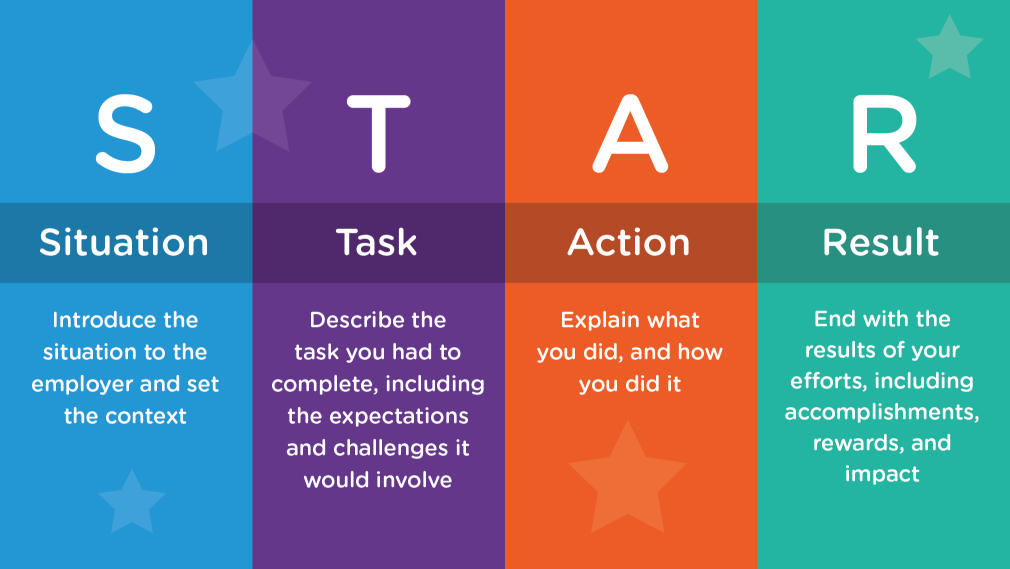
How does the STAR method work in recruitment?
- Useful information
- 29.11.2020
An interview is often the most stressful moment of recruitment. Sending documents, looking for relevant advertisements or a phone call does not evoke as many emotions in us as meeting a recruiter face to face. We don’t know what to say to like ourselves, what sentences to avoid. We learn the answers to the most frequently asked questions by heart and all we want is it to be over. Of course, this is not always the case, but we hear about nervousness much more than relative ease. Therefore, the STAR method can help. This enables us to learn how to respond to recruiters so that they like them.

Stressful job interview
In theory, we shouldn’t stress ourselves before an interview. After all, we know our professional experience, we know what we can do. Nevertheless, it is difficult to predict what the recruiter will ask us about, and sometimes these are tricky questions.
This is why the interview is so stressful for us. There are, of course, methods to reduce anxiety. First of all, you need to be well prepared for this stage of recruitment – read about the company, its mission, check what questions recruiters can ask, think about your strengths and weaknesses, and remember your successes. This makes it harder for us to get a question that we won’t be able to answer in any way.
STAR method in recruiting
When we talk about methods in recruitment, we usually think of those used by recruiters to screen a candidate. It turns out, however, that he, too, can use certain amenities and methods. One of them is the STAR method, thanks to which we can better cope with answering questions and thus reduce the stress associated with recruitment.
The STAR method, otherwise known as the star method, consists of 4 elements that they are also an extension of the shortcut:
S – Situation – Situation
T – Task – Task
A – Action – Action
R – Result – Solution.
What is the STAR method?
The mere expansion of the abbreviation does not tell us much. What is the STAR method and why is it worth remembering and applying during interviews? It is helpful in constructing answers to questions. First, let’s take a look at the shortcuts.
How do I build an answer to a recruiter’s question?
As we mentioned, the STAR method can be used to construct an answer to a recruiter’s question. Let’s break it down into 4 parts:
S – Situation – Think about the situation you will cite in response to the question asked by the recruiter. Define it specifically and briefly. Don’t drag on stories, avoid spilling water. Answer the questions about what exactly happened, when and why.
T – Task – Task – we already know what situation you will be talking about. Now you must mention what you had to do to solve the problem that arose. What tasks did you assign to yourself or someone assigned you?
A – Action – Action – this item is an answer to the question, what did you do to achieve the goal, how did you act, what help did you use.
R – Result – Solution – in the last part you talk about what your results were and whether the goal was achieved.

When the STAR method is it useful?
So as you can see STAR will come in handy when you have questions about solving problems or difficult situations. Thanks to this, we will not omit any important information, we will answer specifically, we will also show how we solved a given situation.
It is worth remembering how to construct answers, but let’s not forget that the knowledge itself method is not enough. We need to know what we are talking about. Preparation for an interview is always a key issue.
STAR method by example
Question by a recruiter: How do you cope when you have to work under pressure time?
Answer using the STAR method:
S: In the company where I worked on the projects, we had specific deadlines for work, thanks to which we could plan it carefully. We were to submit a very important project by November 9. We had 4 months to complete it, so we spread our work. Two months after the assignment started, it turned out that the supervisor made a mistake and the deadline for the project was October 9.
T: We had to fit two months of work into one. Fortunately, we predicted the margin of error in advance, but not so large that a month of tasks would fit in it. I gave up preparing materials for the next project and other less important tasks that I could easily postpone. I was only dealing with this particular project. My colleagues from my team did the same.
A: We focused only on one task, sometimes we also worked overtime, but nevertheless we rested and recharged the batteries during the day, so we wouldn’t burn out along the way.
R: Thanks to postponing non-urgent tasks, focusing only on one project, and spending a few overtime hours, we were able to deliver the task on time.
STAR method can help us construct our thoughts appropriately, which will certainly be useful during recruitment. It’s worth using it!
